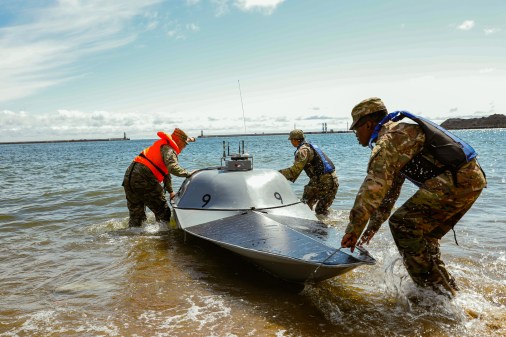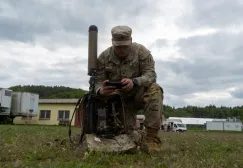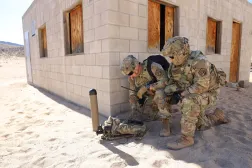How Army leaders envision non-kinetic capabilities enabling traditional forces

Recent experimentation with the Multi-Domain Task Force in the Pacific demonstrated to top Army leadership the impact non-kinetic effects can have on the battlefield and how they can enable other forces and capabilities.
While the MDTF was created, in part, to provide the Army long-range fires capabilities, the service’s secretary said their non-kinetic weapons are sometimes overlooked and can be an important facilitator. In U.S. military parlance, the term “kinetic” generally refers to missiles or other traditional types of weapon systems that physically engage targets, whereas non-kinetic tools can include cyber, electronic warfare and other means of attack.
“What I think is starting to come together, from what I saw, is the possibility of using the non-kinetic effects to be able to sort of open up windows in time in a very anti-access, area-denial environment where we can then use kinetic fires. That was sort of a connection that I hadn’t seen us make up until recently,” Christine Wormuth said Tuesday during an event hosted by the Center for Strategic and International Studies, describing observations from this summer’s Talisman Sabre exercise. “There’s a tendency to focus on the fires function of the Multi-Domain Task Force — thinking about the battalion that will have [the Precision Strike Missile], for example, or the long-range hypersonic weapon. And I think sometimes that comes at the expense of the non-kinetic capabilities that the Multi-Domain Task Force has.”
The MDTF was created in 2017. There are now three in existence with one focused on Europe and two on the Pacific. The organization was designed to be in constant contact with adversaries during the so-called competition phase of conflict. It is capable of deep sensing and long-range precision fires and focused primarily on the strategic level.
The task force has a non-kinetic unit that possesses cyber, electronic warfare, information and space capabilities. It was formerly called the I2CEWS because it included intelligence, information, cyber, electronic warfare and space capabilities and personnel. It’s now known as the Multi-Domain Effects Battalion.
Wormuth noted that these non-kinetic capabilities can help obscure friendly units.
“What I am talking about is, speaking of sensing, for example, so obviously, if an adversary is out there trying to sense where we are to presumably target us, for example — if we are able to use cyber capabilities or EW capabilities or space capabilities, for example, or some combination to be able to block that view of what we’re doing, that can then open up a window in time for us to launch a kinetic effect,” she said. “That’s, I think, what we’re trying to get to. Given how contested the environment is going to be, we can’t assume that we’re going to have an open window all the time. We have to find ways to open those windows so that we can bring our fires capability.”
Previously, officials have noted that the MDTF will play a key role for the joint force when it comes to targeting — both with kinetic and non-kinetic weapons – by using its deep sensing capabilities, which can also extend into kinetic and non-kinetic spaces.
For example, long-range electronic warfare and sensing capabilities can help cue forces to be able to locate enemy assets.
“The Multi-Domain Task Force is the task force that is going to continue to do the target development for the joint force. And it’s going to be able to fuse together information at speeds and then be able to share that with other joint assets and other joint capabilities, which puts the Army and the Multi-domain Task Force as a central and critical role in joint targeting,” Gen. Charles Flynn, commander of Army Pacific, said last year. “The joint advances that are made by the Multi-Domain Task Force are critical in land contributions to the joint force for targeting.”
Sources have indicated in the past that the Army’s Pacific-focused Multi-Domain Task Forces will work to enable its sister services to poke holes in adversary defenses, commonly referred to in military parlance as anti-access, area denial— which refers to the combination of long-range sensors and weapons that threaten friendly forces and force them to operate from farther away.
Capabilities they’ll possess, once fully developed and fielded, include the Electronic Warfare Planning and Management Tool, a command-and-control planning capability that allows forces to visualize the potential effects of these types of weapons and chart courses of action to prevent their forces and systems from being jammed during operations; Multi-Function Electronic Warfare, an airborne pod that’s designed as the first brigade-organic airborne electronic attack asset and can provide limited cyberattack capability; and the Terrestrial Layer System-Echelons Above Brigade, a capability that will be designed for higher echelons that will need to monitor and sense the battlefield across greater distances.
Gen. Randy George, the Army’s vice chief of staff and acting chief of staff, noted that beyond cyber and electronic warfare, the Army is looking at directed energy as a non-kinetic enabler.
“These are things that we’re experimenting with and trying to move forward. But again, if you get to a way where you have magazine depths with that, at a much cheaper for cost per round, so to speak, I think that will help as well,” he said at the CSIS conference.






